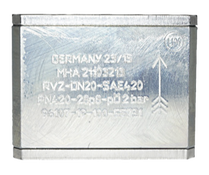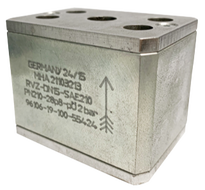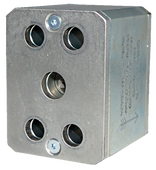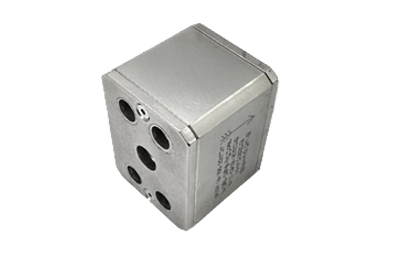|
|
RVZ-SAE check valves are check valves loaded with spring and SAE flange adapter connection ports at both ends. They are made following the International Standard Organization SAE 3000 (ISO 6162-1) and SAE 6000 (ISO 6162-2). Also, they are made with specifications that accommodate working with code 61 or 62 high pressure SAE flange. They are made from carbon steel (28p8) and stainless steel (SS316; 44p8) materials. With a working pressure of 210 Bar (3000 PSI) and 420 Bar (6000 PSI), the SAE flange check valve has a model type of RVZ-SAE. The available sizes for the RVZ-SAE check valve are between 1/2” to 2”. They are designed to enable one flow direction of fluids in hydraulic systems and also prevent backflow. The valve also has a cracking pressure of 2 bars. |
Material Specification |
|
Connection Type |
|
Size |
|
Working Pressure |
|
1. What are RVZ-SAE Check Valves?
Check valves also known as non-return valves are valves designed to allow passage of fluids in one direction. They are two-port valves that have one port for inlet and the other for an outlet of fluids.
RVZ-SAE check valves are check valves with a flange port and adapter on each side. The flange check valves also allow the flow of fluids in hydraulic in one direction. This is mainly used on the system to prevent backflow. Therefore, it is a device that locks a hydraulic cylinder and other components to ensure the flow direction of fluids doesn’t return backwards (backflow).
RVZ-SAE check valves are check valves with a flange port and adapter on each side. The flange check valves also allow the flow of fluids in hydraulic in one direction. This is mainly used on the system to prevent backflow. Therefore, it is a device that locks a hydraulic cylinder and other components to ensure the flow direction of fluids doesn’t return backwards (backflow).
|
The major component of the RVZ-SAE check valves includes the body, seat, O-rings, and Poppet. The valve body is the housing case for the other valves in the system. The body of the RVZ-SAE check valves aids the effective functioning of the system and also channels the fluid through the right path.
The seat is an area that rests the other valves in a hydraulic system. It is an important part of the system as an improperly placed valve seat may lead to leakage of fluids during the operation of the system. O-rings are ring-like gaskets or seals placed in joints and made from rubber materials. The poppet is a valve in the inner part of the system used to measure the flow of gas and vapor passing through the system. |
2. What material is the RVZ-SAE Check Valve made of?
The RVZ-SAE check valve is generally made of carbon steel and stainless steel. The valve material has to be compatible with the system and the combination of material is represented with a code to indicate the material for the parts.
Material |
Stainless Steel, 44p8 |
Carbon Steel, 28p8 |
Cracking Pressure |
2 Bar |
2 Bar |
Body |
Stainless Steel |
Steel |
Seat |
Polyurethane |
Polyurethane |
T min/ T max |
-20⁰C / 100⁰C |
-20⁰C / 100⁰C |
Poppet |
Stainless Steel |
Steel |
O-rings |
FPM |
FPM |
3. What does the arrow on RVZ-SAE Check Valve mean?
|
RVZ-SAE check valves are designed with an SAE flange adapter placed on both ends of the valve. The arrow marking placed on the body of the valve is an indicator of the position of the inlet and outlet flow valves. The direction should be considered strictly so that the inflow may run smoothly and the poppet pushed for outflow.
The complete set of an RVZ-SAE check valve has 2 O-rings, 2 SAE holding plates, and 1 check valve body. For systems requiring adapter plates, it will be provided upon request. |
4. How does the RVZ-SAE Check Valve works?
|
The first flow from the valve has a pressure called the cracking pressing. The poppet or spring closes the valve to avoid backflow from the system when the pressure increases above the cracking pressure. The flow in the check valve runs smoothly through the steel poppet that unseats facing a 2 bar spring. This tow bar spring is the cracking pressure for the RVZ-SAE check valve.
The poppet then reseats to avoid backflow after the flow stops. The backflow is also avoided by an orifice specially produced for the valve. Cracking pressures may fall between -30% to +30% based on manufacturing tolerances and it can be customized if requested. |
5. How can you order an RVZ-SAE Check Valve?
The working pressure of the RVZ-SAE check valve is 210 bar and 420 bar. The valves are produced in sizes ranging from DN15 to DN 50 or 1/2” to 2”.
Here’s a table showing the sizes and other information for the RVZ-SAE check valve:
Here’s a table showing the sizes and other information for the RVZ-SAE check valve:
Size (DN) |
Size (Inch) |
Working Pressure (Bar) |
Unit Weight (kg) |
Valve Types |
Flange Type |
DN15 |
1/2" |
210 |
1.10 |
RVZ-DN-15-SAE210 |
SAE210 |
DN20 |
3/4” |
210 |
1.50 |
RVZ-DN-20-SAE210 |
SAE210 |
DN25 |
1” |
210 |
2.30 |
RVZ-DN-25-SAE210 |
SAE210 |
DN32 |
1 1/4” |
210 |
3.45 |
RVZ-DN-32-SAE210 |
SAE210 |
DN40 |
1 1/2” |
210 |
4.85 |
RVZ-DN-40-SAE210 |
SAE210 |
DN50 |
2” |
210 |
7.80 |
RVZ-DN-50-SAE210 |
SAE210 |
DN15 |
1/2" |
420 |
1.10 |
RVZ-DN-15-SAE420 |
SAE420 |
DN20 |
3/4” |
420 |
1.50 |
RVZ-DN20-SAE420 |
SAE420 |
DN25 |
1” |
420 |
2.30 |
RVZ-DN-25-SAE420 |
SAE420 |
DN32 |
1 1/4" |
420 |
3.45 |
RVZ-DN-32-SAE420 |
SAE420 |
DN40 |
1 1/2" |
420 |
4.85 |
RVZ-DN-40-SAE420 |
SAE420 |
DN50 |
2" |
420 |
7.80 |
RVZ-DN-50-SAE420 |
SAE420 |
|
The check valve is designed with SAE flanges at both ends and this is installed using an SAE flange female side which is connected to the two ends of the flat side flange. This connection enables the fluid to pass through the check valve and SAE flanges. For the RVZ-SAE check valves, four SAE connection types are used. This is shown in the table on right:
|
|
6. How can you recognize a tested RVZ-SAE Check Valve?
The MHA-ZENTGRAF company carries out a batch test on valves produced by them before disbursing out of the company. This test is to ascertain the leakage requirement and working pressure for each valve standard is achieved before selling out. The tests are carried out using the standard DIN EN 122661-1 and methods P10, P11, and P12.
Method P10: This tests the strength of the body with 1.5 multiplied by the nominal pressure (PN) while the ball is opened halfway.
Method P11: This tests the leakage of the stem and body using a maximum of 0.6 MPA of air or 1.5 multiplied by the nominal pressure (PN) while the ball is opened halfway and under timing.
Method P12: the ball seats are being tested for leakage using 0.6 M Pa of air or 1.1 multiplied by the nominal pressure (PN).
In the package of the RVZ-SAE check valve, a valve report indicating each heat number is placed in it. However, testing can be carried out if requested.
Method P10: This tests the strength of the body with 1.5 multiplied by the nominal pressure (PN) while the ball is opened halfway.
Method P11: This tests the leakage of the stem and body using a maximum of 0.6 MPA of air or 1.5 multiplied by the nominal pressure (PN) while the ball is opened halfway and under timing.
Method P12: the ball seats are being tested for leakage using 0.6 M Pa of air or 1.1 multiplied by the nominal pressure (PN).
In the package of the RVZ-SAE check valve, a valve report indicating each heat number is placed in it. However, testing can be carried out if requested.
SAE FLANGE CHECK VALVES CATALOGUE









